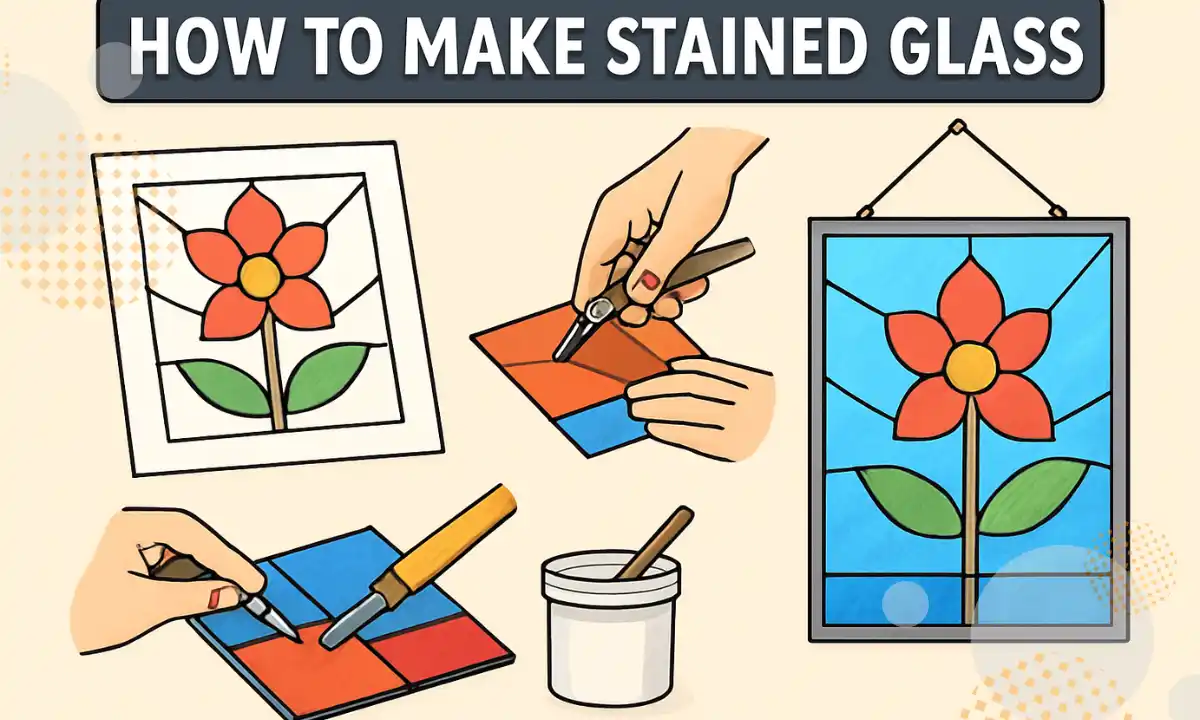Stained glass has been around for centuries as a way to recreate beauty and elegance in windows, lamps, and decorative articles. Whether you are interested in the interestingly huge stained glass windows of churches, or more simple applications of stained glass for home décor that you could do yourself, discovering how to make stained glass will give you a wonderful creative challenge. With the right tools, techniques, and some patience, you will be able to create stained glass art that is simply beautiful!
What is Stained Glass?
Stained glass can refer to colored pieces of glass that are cut, arranged, and joined together to form specific patterns, designs, or images. Stained glass has historically been utilized in cathedrals and palaces, but is also commonly used today in home decor, art projects and jewelry making.
Tools & Materials Needed for Stained Glass
Before you get started on your first stained glass project, it is important to have the right tools and materials! Having the right supplies will make it easier, and ensure safety and quality in your finished piece. Here are the essential tools and materials you will need:
1. Glass Sheets
The foundation of stained glass art lies in colorful glass sheets. Choose from a variety of textures, shades, and transparency levels depending on your design. Beginners should start with easy-to-cut glass to practice.
2. Glass Cutter
A glass cutter is an essential tool used to score the glass before breaking it. A high-quality cutter ensures clean lines and reduces the chances of cracks, helping you achieve precision in your design.
3. Running Pliers
After scoring, running pliers help in neatly snapping the glass along the scored lines. This tool is especially useful for beginners, as it reduces breakage and provides accurate cuts.
4. Copper Foil or Lead Came
To assemble the glass pieces, you’ll need either copper foil tape or lead came. Copper foil is more popular for intricate designs, while lead came is often used in traditional, larger stained glass projects.
5. Soldering Iron & Solder
A soldering iron along with solder is required to join the foiled or leaded glass pieces together. This step ensures durability and gives strength to your stained glass artwork.
6. Flux & Flux Brush
Applying flux with a flux brush prepares the copper foil for soldering by allowing the solder to flow smoothly and bond properly. Without flux, soldering would be difficult and uneven.
7. Safety Glasses & Gloves
Working with sharp glass and hot tools can be risky. Wearing safety glasses and gloves is a must to protect your eyes from glass shards and your hands from burns or cuts.
8. Workbench & Cutting Surface
A sturdy workbench with a proper cutting surface is essential for stability while working. It provides the right space to cut, assemble, and solder your stained glass pieces safely and efficiently.
Step-by-Step Guide on How to Make Stained Glass
1. Design Your Pattern
- Start with a simple drawing or template.
- Use bold, clear lines and avoid overly complex shapes if you’re a beginner.
2. Choose and Cut the Glass
- Select colored glass sheets based on your design.
- Score the glass with a cutter along your pattern lines.
- Use running pliers to snap the pieces neatly.
3. Grind and Smooth Edges
- Use a glass grinder to smooth sharp edges.
- This ensures better fitting and safety when assembling pieces.
4. Apply Copper Foil or Lead Came
- Wrap each glass piece with copper foil tape or place them in lead came channels.
- Press the foil firmly so it sticks evenly.
5. Solder the Pieces Together
- Place your glass pieces on the workbench as per your design.
- Apply flux to the copper foil.
- Heat the soldering iron and carefully join the pieces with solder.
6. Clean and Finish
- Wipe off excess flux and polish the stained glass with a soft cloth.
- Optionally, you can add patina to change solder color (black, copper, or silver).
Safety Tips for Making Stained Glass
- Always wear safety glasses and gloves.
- Work in a well-ventilated area.
- Handle glass with care to avoid cuts.
- Keep soldering tools away from children and flammable materials.
Creative Ideas for Stained Glass Projects
- Window panels
- Lampshades
- Wall art
- Sun catchers
- Decorative ornaments
Conclusion
Although stained glass may seem intimidating at first, with a little practice it will be a fun and rewarding hobby. You will go through all kinds of processes: glass cutting, grinding the edges off, layering and design, soldering, and the last step: to admire your art! Whether a simple sun catcher or traditional window panel, stained glass art has a permanent beauty wherever you decide to use it.
